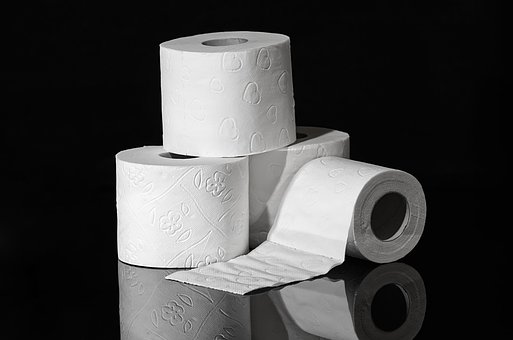 There is a huge argument going on about how to put toilet paper on its hanger. Does it roll so the paper comes off the front or the back? Well without the invention of toilet paper, we wouldn't be having that argument.
There is a huge argument going on about how to put toilet paper on its hanger. Does it roll so the paper comes off the front or the back? Well without the invention of toilet paper, we wouldn't be having that argument.Back in the second century B.C, someone in China invented a wrapping and padding paper. Records show this paper was also used as toilet paper. By the 6th century, this type of toilet paper was used across the country but the first modern version did not appear until 1361.
It was created to meet the needs of the Chinese Royal family. Every 2 foot by 3 foot sheet was perfumed, much like what we have today. However, it wouldn't be until the fifteenth that it became widely available to everyone and it wasn't always what we think of as toilet paper. People often used newsprint or other general paper until people began commercially producing it.
In fact, mass manufacturing of modern toilet paper didn't begin until the 19th century, when Joseph C. Gayetty created the first packaged variety to be sold commercially in 1857. The packages contained flat, loose, sheets of paper made out of hemp with aloe and marketed as "Therapeutic Paper" in Kleenex like boxes. To make sure everyone knew it was his paper, he put his name on every sheet but it wasn't successful because most people used the pages from their Sears Catalogue which came free every season.
Within ten years, several men including Scott produced some sort of toilet paper but it wasn't until the Scott brothers formed the Scott Paper Company in 1879 that toilet paper was sold in rolls. They distributed their paper to drugstores and hotels but it was still a battle because people had to be convinced toilet paper was worth it. At this point, discussing bodily functions was not done, so the public had to be educated. In fact, the Scott Brothers didn't take credit for their product until 1902 due to being ashamed.
One thing that helped was between 1870 and 1890, people patented and build a variety of machines that would roll and perforate toilet paper to make it easier to use by individuals but it couldn't get past the shame and no one wanted to ask about it by name. In 1930, the German toilet paper company started the campaign telling people to ask for their brand so they didn't have to say the words "Toilet Paper.
A big societal change that helped toilet paper become more accepted had to do with the change from outhouses to indoor plumbing. This new sit down flush toilet required a paper that could be flushed down the pipes without clogging them. This lead to toilet paper companies stating their products came recommended by both doctors and plumbers.
In 1928, Hoberg Paper Company located in Green Bay, Wisconsin listened to its advertising department and introduced Charmin with ladylike packaging and associated femininity with it so they could avoid talking about its actual purpose. Furthermore, in 1932, Charmin started packaging toilet paper in bundles of four and this helped the company survive the depression. Then in 1935, when Northern produced the first splinter free paper and then in 1942, Saint Andrews Paper Mill in England figured out how to make a softer paper and begin issuing rolls of two ply paper.
So this is how we came to be so into toilet paper use in North America and Europe. Toilet paper is still evolving and it will be interesting to see where it ends up going. Let me know what you think, I'd love to hear. Have a great day.
No comments:
Post a Comment